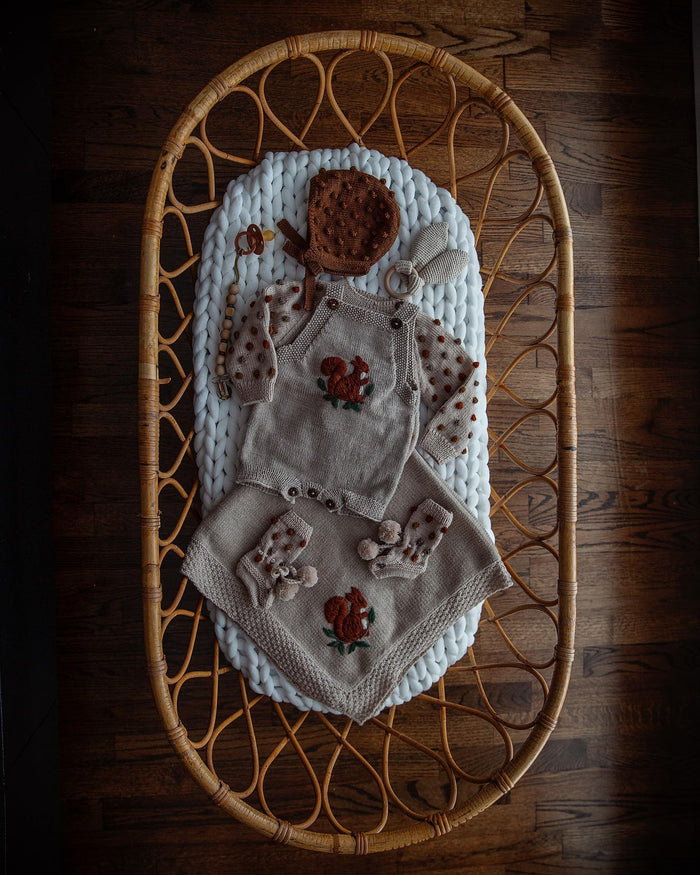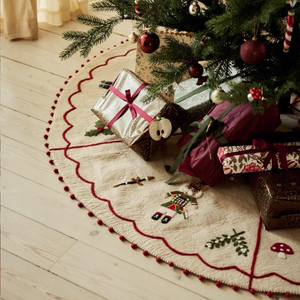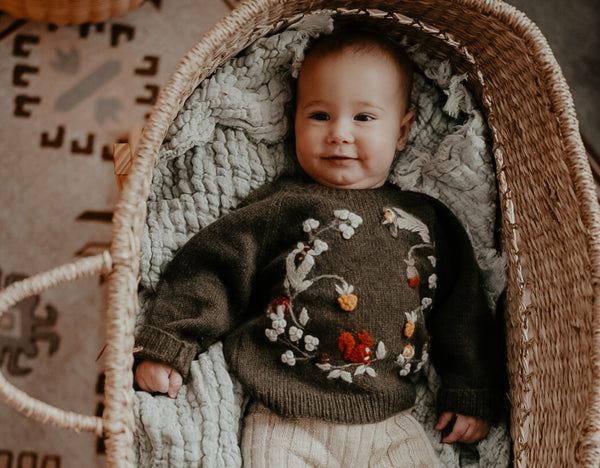5 simple tips for dressing your newborn from the talented mamas in our Kathmandu studio.
The blissful haze of the newborn days is an emotional yet fleeting stage in a lifetime with your little. Between bottles, diapers, and sleep schedules (or lack thereof), you also need to figure out how to dress your tiny baby. Breathe, mama—it’s easier than you think.
We asked the team of women from our Kathmandu studio for advice, as we’ve all faced some confusion and uncertainty about newborn dressing at one point or another. They’re all mothers who create the treasure-forever heirloom garments for our collections, so they have plenty of experience dressing the delicate bodies of newborn babies. From carefully selecting natural fabrics to smart double-layering techniques, they share their top tips on how to dress a newborn baby:
1. Layer Up
From the moment they’re born, babies are dependent on their mothers for everything, and that includes temperature control. Unlike adults, newborn babies can’t regulate their heat and they rely on you to maintain their body temperature (between 36.5 and 37 degrees).
Layering is a great way to help your little one stay comfortable. The general rule of thumb is your newborn should be wearing one more layer than you have on in the same conditions. Opt for natural fibers like cotton or linen as they’re airy and more breathable than synthetics.
Shirley, Owner: “I used a two-layer technique for my baby, with soft cotton on the skin and merino wool or cashmere as the second layer. We love wool in our family as it’s a great natural textile for regulating heat. Wool absorbs moisture and releases heat when it’s warm, and in cold weather the natural crimp of wool fibers creates tiny pockets of trapped warm air that act as insulators. Wool is so smart!”
2. Choose Natural Fabrics
There are many reasons to dress your newborn in natural fabrics: comfort, durability, breathability, and softness, just to name a few.Reach for textiles like cotton or fine merino wool when dressing your baby.
Bhagwati didi, Artisan: “Newborns spend most of their time lying on their backs or being carried around, so it’s important to choose clothes and beddings that are unembellished, breathable, and made from natural fabrics.
It's also a good idea to wash brand-new clothes before your baby wears them. This protects the baby's sensitive skin from any kind of impurity that the item may have been exposed to during production. Avoid detergents with harsh chemicals and dry clothes in the sun when possible. The sun acts as a great natural disinfectant and helps eliminate any bacteria that might be on the fabrics”.
3. Easy Fastenings
Mastering motherhood is all about making the daily tasks as easy as possible, and that includes dressing your baby. The secret to a seamless newborn wardrobe change? Easy-to-use fastenings. Think snaps, wrap ties, two-way zips, or even magnetic closures that cut down on time at the change table.
Pramila didi, Artisan: “My son was born in the winter, so I always dressed him in warm layers that were easy to put on and remove. He would get hot easily, so I tried to layer with items that have snaps, flaps or string ties to make changes a bit easier. Whenever it got warmer during the day, I would remove some layers to keep his body temperature just right. Layering like this also helps us mamas use those cute outfits we love all year round.”
Sanu didi, Artisan: “I personally think cotton-muslin in a wrap-style is the best way to go for a newborn. I swear by our traditional Nepali Dhaka bhoto set for babies. The set usually has a vest (bhoto), bonnet (topi), shirt, trousers, mittens and a blanket. The pure cotton fabric (Dhaka) is sewn between two layers of soft muslin, making it breathable and lightweight for the baby during the summer. For winter, I used the quilted version of the Dhaka set and then layered on a soft sweater or cardigan to protect my baby from the cold. It is really the perfect daily wear for babies. The Dhaka blanket is such an ideal multi-purpose fabric and works best as a swaddle to cocoon the baby. Lightweight yet strong, it’s a muslin wrap that will not overheat the baby and will keep them safe and super cozy”.
4. Quality Over Quantity
How many times have you heard a mama say, “Time is a thief”? It’s true—the newborn stage is beautiful, messy, wonderful, scary, exciting, exhausting and above all: fleeting. Don’t buy a plethora of unnecessary clothing for this stage; instead, invest in a few, high-quality staples that you can count on time and time again. At Shirley Bredal we take pride in crafting true heirloom pieces, hand-crafted styles that are meant to be well worn and then passed on for generations to come.

Lakshmi didi, Artisan: “For dressing newborns, my advice is buy less—invest in only a few high-quality pieces. The clothes should be all about the comfort and safety of the baby, and they should be selected with the baby’s environment in mind (warmer clothes for winter, lighter layers in the summer heat). Babies also grow out of clothes very quickly, so it is best to purchase just the newborn essentials; natural fibers like the Dhaka set were my go-to all year round, and I layered with soft wool sweaters and fleece jackets during chilly Nepali winters”.
5. One-And-Done Rompers
If you’re struggling with a squirmy baby and two-piece sets, rompers and bodysuits are a great one-and-done option for effortless newborn outfit changes.
Puja didi, Artisan: “I am a big fan of romper and bodysuits for newborns; both cotton and merino wool. They act as a top as well as a bottom for the baby, and they are so spacious and practical. The flap or button fastenings make it super easy to change diapers, and some pieces feature snaps at the shoulders to make dressing or undressing the baby that much easier. These one-pieces are my go-to gift for any mum-to-be”.
The Magic of Natural Fibers
We only use the highest quality natural textiles in our collections, so your little ones stay cozy and comfortable from morning to night.
Comfort
We carefully select natural fabrics with a smooth and soft handle that provide the highest level of comfort for your baby. Also, our textiles are never treated with any harmful chemicals that could irritate your baby’s sensitive skin.
Breathability
Babies should wear lightweight fabrics that help circulate airflow, so natural fibers like cotton and muslin are great breathable options that can be easily layered and will help prevent your baby from overheating.
Durability
There’s a peace of mind that comes with knowing the fabrics and clothing your newborn is wearing is built to last—no loose threads, unravelling or deterioration. Natural fabrics like hemp have incredible tensile strength and will maintain its integrity, shape, and softness after repeated laundering.
Hypoallergenic & Antibacterial
Natural fabrics like wool and cotton are naturally hypoallergenic and possess anti-bacterial properties, making them a great choice for babies who may have sensitive skin or allergies.
Biodegradable
Untreated natural fabrics like the ones we use in our collections are 100% biodegradable, so you can feel good knowing you’re caring for your baby and the environment.
Click here to explore our newborn collection featuring beautiful, hand-selected natural fabrics.












